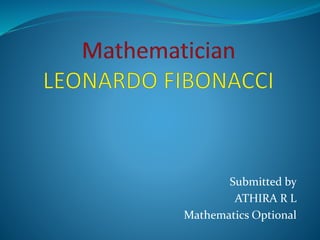
Leonardo fibonacci
- 1. Submitted by ATHIRA R L Mathematics Optional
- 3. Leonardo Fibonacci was an Italian mathematician who lived from around 1170 to around 1250. He spent most of his life in Pisa. When he was still a teenager, he travelled to Bugia, in North Africa, to join his father who had gone there to handle international trade for Pisa, then one of the major Mediterranean commercial hubs. While there, he observed Muslim traders using a remarkable method for performing calculations. Instead of using finger-counting or a physical counting-table, they wrote numbers on parchment using just ten symbols, 0, 1, 2, 3, 4, 5, 6, 7, 8, 9, and calculated by manipulating the symbols according to certain rules.
- 4. On his return to Pisa, Leonardo wrote a mammoth book describing this remarkable new way to write numbers and calculate with them, called “Liber abbaci”, which translates from the Latin as “Book of Calculation”. (Not the “book of the abacus”, spelt with one b.) Completed in 1202, this book is generally credited with bringing the Hindu-Arabic number system and its arithmetic (as the system is now known) to Europe, and launching the modern, Western-led, commercial world.
- 5. Fibonacci's Mathematical Contributions Introducing the Decimal Number system into Europe He was one of the first people to introduce the Hindu- Arabic number system into Europe - the positional system we use today - based on ten digits with its decimal point and a symbol for zero: 1 2 3 4 5 6 7 8 9 0 His book on how to do arithmetic in the decimal system, called Liber abbaci (meaning Book of the Abacus or Book of Calculating) completed in 1202 persuaded many European mathematicians of his day to use this "new" system.
- 6. The book describes (in Latin) the rules we all now learn at elementary school for adding numbers, subtracting, multiplying and dividing, together with many problems to illustrate the methods: 1 7 4 + 1 7 4 - 1 7 4 x 1 7 4 ÷ 28 2 8 2 8 2 8 is ----- ----- ------- 2 0 2 1 4 6 3 4 8 0 + 6 remainder 6 ----- ----- 1 3 9 2 ------- 4 8 7 2 ------- Let's first of all look at the Roman number system still in use in Europe at that time (1200) and see how awkward it was for arithmetic.
- 7. Roman Numerals The Numerals are letters The method in use in Europe until then used the Roman numerals: I = 1, V = 5, X = 10, L = 50, C = 100, D = 500 and M = 1000 You can still see them used on foundation stones of old buildings and on some clocks.
- 8. The Decimal Positional System The system that Fibonacci introduced into Europe came from India and Arabia and used the Arabic symbols 1, 2, 3, 4, 5, 6, 7, 8, 9 with, most importantly, a symbol for zero 0. This decimal positional system, as we call it, uses the ten symbols of Arabic origin and the "methods" used by Indian Hindu mathematicians many years before they were imported into Europe. It has been commented that in India, the concept of nothing is important in its early religion and philosophy and so it was much more natural to have a symbol for it than for the Latin (Roman) and Greek systems.
- 10. The first edition of Liber abbaci has not survived. Leonardo completed a second edition in 1228, and several copies exist dating from the late 13th or early 14th centuries. He wrote a shorter, simpler account of Hindu-Arabic arithmetic, Libro di minor guisa (“Book in a smaller manner”) aimed at merchants, which modern historians think was the work most responsible for popularizing the new methods in Europe, but no copies have been found.
- 11. Three other books survive: Practica geometriae (1220) is a geometry textbook based on Euclid’s writings, Flos (1225) presents Leonardo’s solutions to a series of challenge problems posed to him in a public display by a mathematician in the Court of the Emperor Frederick II,and Liber quadratorum (“Book of Squares”, 1225) is an impressive number theory book which, among other things, examines methods to find Pythagorean triples.
- 12. The Fibonacci sequence The name “Fibonacci” is most widely known today not because Leonardo was the man who introduced modern arithmetic into Europe, rather in connection with the “Fibonacci sequence”, an unending sequence of natural numbers that begins 1, 1, 2, 3, 5, 8, 13, 21, 34, 55, 89, 144, 233, 377, ... The rule for generating new numbers in the sequence is that each number is the sum of the two preceding numbers, so 1+1=2, 1+2=3, 2+3=5, etc. This sequence arises when you solve a particular problem Leonardo gave in Liber abbaci (p.404 of Laurence Sigler’s English translation):
- 13. How Many Pairs of Rabbits Are Created by One Pair in One Year. A certain man had one pair of rabbits together in a certain enclosed place, and one wishes to know how many are created from the pair in one year when it is the nature of them in a single month to bear another pair, and in the second month those born to bear also. The numbers of pairs each month are the Fibonacci numbers. You can read off the answer to Leonardo’s problem: 377 pairs. The problem and its solution dates back well before Leonardo.